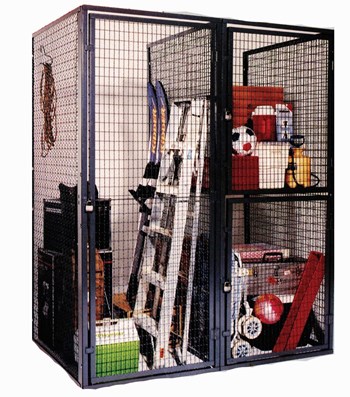
The perks of living in the Garden State are obvious to anyone reading these pages, and won’t be listed here. But there is one glaring drawback to living in a densely populated metropolitan area: lack of space. We all have winter coats we don’t need in August, air conditioners we don’t use in February, and a lifetime of old tax returns, pay stubs and back-issues of magazines we subscribed to in 1992 that we can’t bear to part with. Where to put all that stuff? It won’t all fit under the bed.
Almost since their inception, condo buildings, co-ops and many HOAs have sought creative solutions to their residents’ storage challenges. Some convert basement space to storage units, others make available racks for bicycles. But the demand for more storage space is as limitless as the human capacity for nostalgia.
“Every building has, needs, or wants to re-do their storage area,” says Josh Goldman, president of Bargold Storage Systems in Long Island City, which does business throughout the tri-state area. “Storage is the single most-used amenity, even more than laundry.”
A parking spot, says Goldman, is not an absolute necessity—particularly in PATH- and New Jersey Transit-connected riverside communities. Laundry can be taken to the wash-and-fold and returned the next day. But extra space for extra stuff? “Everyone will take advantage of it,” he says. “If a building has storage, it’s something everyone can use. You want to get your name on that list. Even if you don’t need it, you’ll use it. New developments allocate space for everything, and will usually have a storage area or a storage room.”
Steel vs. Wire
There are several common formats for storage units or lockers that can be installed in a multifamily building. One popular type is made of wire—either woven or welded. These are essentially wire cages that occupy the basement rooms of many a New Jersey building.
There are three main advantages to wire units. The first? “Cost,” says Devon Fields of SpaceGuard Products in Seymour, Indiana, a company that manufactures units for all markets, including New Jersey and New York. “Wire is significantly cheaper than fully enclosed units.” For a building planning to purchase and maintain the units in-house, that’s valuable.
The second advantage is modularity. “You have the ability move [the units] around,” Fields explains. “They're anchored to the floor, so they won’t go anywhere if you don't want them to. But if you do want to, you can unlock them and move them around” for greater flexibility. These units are analogous to freestanding, more modular bookcases versus ones built directly into the wall.
Lastly, there's the matter of oversight. There are some limitations on what can be safely—or legally—stored in these units; you wouldn't want to roll up your Rembrandts and leave them there; you don't want a contractor setting up a workspace in there; you can’t let someone set up a cot and sublet it to their buddy who's passing through town. Woven or welded, wire mesh literally keeps things transparent. It also has the advantage of not being as closed-in and potentially claustrophobic as fully-enclosed units can feel, particularly in a subterannean space like a building basement.
Handy as it is however, wire does also have its downsides—and some of its advantages might not be as advantageous as they seem at first glance.
First, the wire does not keep out dust or moisture, which can be issues in even the most spic-and-span basements. “You generally don't want to keep alternate season clothing in a wire unit,” Goldman says. Without a lot of protective packing, the clothes would be ruined.
Dust isn’t the only thing that can get through the diamond openings in the wire. If the area around the storage space isn't immaculate – and sometimes even if it is—mice, rats, roaches, and any other sort of thing that goes bump in the night can mosey in and out of those cages at will. Aside from being gross, this can be unsanitary, and it also limits what can be stored in a wire unit.
And there are those who don't feel that wire units necessarily allow a board greater oversight over what's being stored. “People store things in boxes, ” Goldman says. “You still won’t have any idea what’s in those boxes.”
Finally, there is the issue of security. While wire units with good padlocks in a residential building should be reasonably secure, the fact remains that even six-gauge steel wire can be cut through more easily than a solid steel wall. Solid steel can also protect better against fire.“I hate to use the cliché, but [solid steel units] are the Cadillac of the industry,” Goldman says. “If you want to keep yourself secure, and dust and vermin free,” fully enclosed is the way to go, he says.
Rent vs. Own
Buildings have two options with storage units: they can install them at their own expense and then rent them to individual owners, which provides a revenue stream for the building into perpetuity—especially if the units are wire. Or they can have a storage company build in the units themselves and handle the rental as well, in exchange for a percentage of the take.
While most storage companies will construct a storage room for a fee and then end the arrangement, the more common business model is built on the rental. The firm comes in, designs the storage room based on the needs of the client and the space available, builds it with the aforementioned wire or fully-enclosed steel, and then handles all aspects of the rental process.
“There is no out-of-pocket expense [for the HOA],” Goldman says. “For example, if we charge $54 a month for a single steel unit, twenty-five percent goes to the board. We provide detailed paperwork, so there is complete transparency.” Some firms also will throw in a bike rack or other storage element to sweeten the deal.
The rent vs. buy argument is not just a matter of math, but also of extreme weather. After Superstorm Sandy slammed New York City in 2012, Goldman points out, buildings with badly flooded basements had to replace their self-owned storage units themselves. New Jersey and its famed shoreline also got hit very hard as well. “With Sandy, we had to refurbish about 400 units that got flooded,” he says. “If you own them yourself, you’re responsible for that.”
Bicycle Racks
Anyone who has been in the New York-New Jersey area over the last few years cannot fail to notice the explosion of bike-centered facilities and amenities on both sides of the Hudson. With the new emphasis on two-wheeled transportation comes a new issue: where to store all these bikes. We have all been to apartments where bicycles are hanging on the wall by the kitchen table, but that is not the most efficient use of space. For that, it’s best to call in the experts.
Tracie Roberson is the president of Cycle Storage Solutions, a company based in Stevens Point, Wisconsin, that designs and manufactures custom-made bike racks that are then installed all over the country.
“We make all the racks at our facility,” she says. “All are made of steel,” and coated to protect from the elements. One of the rack products is a tiered bike rack, that lifts the bicycles off the floor so stuff can be placed underneath it. These can be modified in many ways—one is to fit spaces with low ceilings. “We can save you space, so your bike room is not only cleaner but more efficient,” she says.
Roberson explains that one of the goals of the company is to protect the bike—not just store it effectively. “We make sure to hold the bike in such a way that is doesn’t bend the rims or scratch the paint,” she says.
Like storage locker firms, bike storage companies will draw a blueprint designed for maximum space efficiency based on the specs of your proposed bike room. Price ranges from $45 per bike—a one-time fee—to $85 a bike for more complicated tiered systems. These costs can easily be recouped by renting the units to cycling residents.
Goldman even speaks of a hanging bike rack that rotates around the room, like the hanging racks at the dry cleaners—it all depends on the wants, needs and budget of the association or the buildings in question.
When it comes to storage, there appears to be no end to human ingenuity. But until some genius invents the shrink ray, or the teleporter—or both!—New Jerseyans will always have need of space.
Greg Olear is a freelance writer and a frequent contributor to The New Jersey Cooperator.






Comments
Leave a Comment